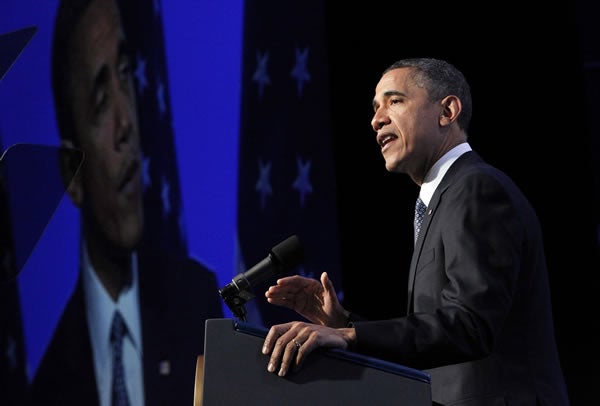If President Obama wants to challenge the House Republican budget passed last week, he certainly should. His views would be more enlightening, however, if they actually said something substantial, instead of the shrill hyperbole he repeated today.
In a speech at an Associated Press luncheon, Mr. Obama branded the House budget “thinly veiled social Darwinism” and “antithetical to our entire history as a land of opportunity.” He said the plan, authored by Budget Committee Chairman Paul D. Ryan (R–WI), would “impose a radical vision on our country” and was a “prescription for decline.”
Well. The Ryan budget is not above a degree of criticism – but it is hardly radical. Its policies are measured and carefully crafted, rooted in sound conservative principles, and aimed at winning consensus. If anything, Ryan’s budget would benefit from more aggressive entitlement reforms—it makes no changes in Medicare and Social Security until 10 years from now. The $331 billion in entitlement savings it calls for over the next 10 years is less than 1 percent of what the federal government will spend in that time, and it is just slightly more than one-fourth of the $1.2 trillion sequestration, scheduled to start in January, that will jeopardize military readiness and slash indiscriminately at a range of domestic programs.
Still, the great virtue of the Ryan budget is it’s the only serious plan that has passed a committee and a chamber of Congress.
Meanwhile, Mr. Obama —while presiding over the fourth straight trillion-dollar-plus deficit of his tenure—acts as if no problem exists. He shunned the recommendations of his own fiscal commission, which called for $4 trillion in deficit reduction. He did an elaborate high-wire act with the House Speaker last year, at the end of which the President got his $2.1 trillion debt ceiling increase without agreeing to a penny of entitlement savings. His budget this year tries to claim credit for $5 trillion in deficit reduction, most of which comes from already enacted legislation, phony war savings, tax hikes, and reduced interest costs. He offers no serious entitlement reforms, merely chipping around the edges. Yet even if all his alleged “deficit reduction” policies were adopted, the President’s budget would increase publicly held debt to more than 76 percent of gross domestic product (GDP) by 2022.
Beyond the next decade, the President’s policies make matters even worse—by the Administration’s own admission. Buried on page 59 of the Analytical Perspectives—one of four volumes that make up the President’s budget submission—is an alarming chart showing the debt-to-GDP ratio rising to 103 percent by 2040 and continuing inexorably upward from then on.
“[T]he deficit and debt begin to rise again in the period after 2022,” says the explanatory text, “with the debt-to-GDP ratio far exceeding its previous peak level reached at the end of World War II.” (That peak was 108.7 percent in 1946.)
In response to this looming fiscal crisis, what does the President offer? More accusatory rhetoric. A President has an obligation to do more. He should at least advance a set of proposals that he believes could start changing the government’s disastrous fiscal course, as the Ryan budget aims to do.
But then again, perhaps in this, as in other matters, he expects to have more “flexibility” in the future.






























7 Replies to “So, Where Is the President’s Solution to the Fiscal Crisis?”